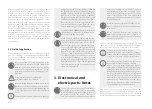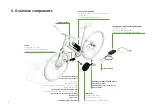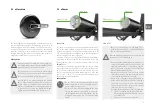
8
• Protect your battery against water and other
liquids. Contact may cause damage to the pro-
tective circuit and the protective mechanism of
the battery. This can result in fire or explosion.
• Do not use high-pressure equipment to clean
your battery. To clean, use a damp cloth. Do
not use aggressive cleaning agents.
• Incorrect handling of the battery may cause
liquid to escape. This liquid can cause irritati-
on and burns on the skin. If you do come into
contact with the battery liquid,
• wash the affected area with plenty of water.
If it comes into contact with your eyes, find a
doctor or medical expert immediately for help.
• If you have handled the battery incorrectly eit-
her on purpose or by accident, so that gases/
vapors escape from it, get access to fresh air
and find a doctor or medical expert immedia-
tely if you have been affected.
• Before undertaking a journey, the battery must
be fully attached in its holder. Otherwise, there
is a danger that it may fall out while you are
riding.
• Prevent a total discharge of the battery at all
costs. Otherwise, irreversible damage to the
battery cells results.
• This battery is designed only for use with Pen-
dix electric bicycle motors. Improper use or
incorrect handling can cause fires or injuries.
Pendix assumes no guarantee or responsibility
of any kind for damage resulting from impro-
per use or treatment.
• Caution: magnetic fields around the battery
plug/holder also influence medical equipment
such as for example heart pacemakers. Always
consult a doctor or medically qualified person
on this subject if in doubt.
ePower aging and attrition
The battery is subject to wear (attrition). With increasing age
and use, it will lose in capacity and the corresponding maxi-
mum distance is reduced. The capacity loss is approximately
10 % per year. This is not a defect, but normal wear. From a
technical point of view, the battery is considered to be worn
out when 60 % of its capacity is reached.
You can continue to use it as before, though you should now
reckon with a lower capacity and a reduction in distance.
There are four charging models available: 60 W/120 W/160
W/200 W. The delivery of the charging unit 120 W/200 W in-
cludes the power station. You can use the charging unit with
or without the power station. To use the power station, sim-
ply insert the plug of the charging unit into the power station
from below. If you do not want to use the power station, you
can only charge the battery in a flat position, as the plug is
fitted into the battery from underneath.
• Use the charging unit for the corresponding
battery only. The battery charge voltage must
be the same as that of the charging unit. Other-
wise, a fire or an explosion may result.
• Make sure you are connecting to the proper
line (mains) power (voltage)! The label on the
charging unit indicates the necessary/ prescri-
bed line power. It must agree with the voltage
coming from the power source.
• Do not touch the mains plug with wet hands!
You may receive an electric shock.
5.3 Charging unit
Please consult the chapter entitled „Charging the battery“
for further information on this subject.
The charging units and batteries are compatible among
themselves and all battery variations can be charged with all
charging units. The following graphic shows the variations:
If your battery is out of use for a longer period,
for example for 3-6 months during a winter break,
it is best to store the battery at a charging level
of 50 % – 80 %. In this way the battery does not
age as quickly as when it is fully charged. Don’t
forget to check the charging level once every 12
weeks, recharging it if necessary. In this case al-
ways make sure that the battery is not comple-
tely empty for a longer period of time, as a total
discharge with irreversible damage to the battery
cells may result.
Storage of the ePower
Store the battery in a dry and well-aired place. To counteract
a loss in the battery’s capacity, the best room temperature is
around 20° C (68 ° F).
If the battery is completely emptied (blinking red display) as
a result of use, it must be recharged within 2-3 days to avoid
total damage.
charging time
battery
60 W
120 W
160 W
200 W
ePower150
2:30 h
1:15 h
1:00 h
0:50 h*
ePower300
5:30 h
2:45 h
2:00 h
1:40 h*
ePower500
8:20 h
5:15 h
3:10 h
2:30 h
charging units 60 W/120 W/160 W/200 W
*ePower150 and 300 can be charged with the 200 W charging
unit as well. Due to the power of the charging unit, the battery
warms up. Depending on the initial temperature and due to
the thermal protective circuit, it is possible that it does not
lead to a shorter charging time compared to the charging
time with the 120 W charging unit.
Safety notes


































